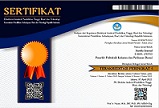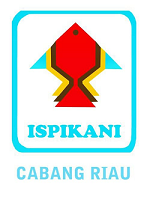TSUNAMI HAZARD ZONE IN THE COASTAL OF PANGANDARAN REGENCY
Abstract
Pangandaran Regency is famous for its natural beauty and favorite tourist destination in West Java, but it also has the potential for earthquakes and tsunamis due to its proximity to the Indo-Australian plate subduction zone. Pangandaran has a history of the 7.7 magnitude earthquake with the tsunami in 2006, to anticipate it again a mapping model is needed related to the vulnerability of the tsunami disaster in Pangandaran in the form of a vulnerability map as well as conducting a survey of vulnerability locations on the coast of Pangandaran. The zoning method is described descriptively using satellite imagery and direct observation, satellite imagery data analyzed are data on slope, elevation, land use, distance from the river and distance from the coastline. The tsunami hazard along the coast of Pangandaran Regency is relatively different from one zone to another, because it is influenced by parameters of morphology, bathymetry and coastal topography. Indicators of coastal slope and bottom of coastal waters play an important role in the magnitude of the potential for a tsunami in a zone, the zoning results show that the Pangandaran coastal area may be directly affected by tsunami waves. The following are high-risk zones which are areas with low altitudes such as the sub-districts: Kertamukti, Ciparanti, Legokjawa, Cijulang, Parigi, Karangbenda, Cibenda, Sukaresik, Wonoharjo, Pananjung, Babakan and Bagolo. These sub-districts need to install signs of tsunami vulnerability in the event of an emergency, it is also necessary to conduct outreach and training on preparedness in the event such as an earthquake and natural signs related to a tsunami or post-tsunami.
Keywords
Full Text:
PDFReferences
Aeda, S. A., Saputro, S., & Subardjo, P. (2017). Simulasi Penjalaran dan Penentuan Run-Up Gelombang Tsunami di Teluk Pangandaran, Jawa barat. Jurnal Oseanografi, 6(1), 254–262.
Aldison, J. (2021). Kajian Jalur Evakuasi Serta Tempat Evakuasi Bencana Tsunami Terhadap Hasil Partisipatif Masyarakat di Pesisir Kecamatan Limau Kabupaten Tanggamus. In Universitas Lampung: Vol. Teknik Geo (Issue Fakultas Teknik). 53 Hal.
Awaludin, N. (2010). Geographical Information Systems with ArcGIS 9. X Principles, Techniques, Applications, and Management. Andi Offset Yogyakarta. 165 Hal.
Badan Informasi Geospasial. (2021). Demnas 1308-23. Badan Informasi Geospasial. https://tanahair.indonesia.go.id/demnas/#/.
Bryant, E. (2014). Tsunami dynamics. In Springer. https://doi.org/10.1007/978-3-319-06133-7_2. Pp 19-32
ESDM, K. (2010). Peta Kawasan Rentan Bencana Tsunami Pangandaran 2010. Https://Vsi.Esdm.Go.Id/.
Ikhwandito, A., Prasetyo, Y., & Nugraha, A.L. (2018). Analisis Perbandingan Model Genangan Tsunami Menggunakan Data Dem Aster, Srtm Dan Terrasar (Studi Kasus: Kabupaten Pangandaran). Jurnal Geodesi Undip, 7(1), 131–141.
Munajat, A. H. (2018). Museum Tsunami Pangandaran Tema High Wave. 35 Hal.
Pawirodikromo, W. (2015). Pengurangan Risiko Bencana Alam Gempa Bumi Sebagai Upaya Untuk Melaksanakan Risk-Based Early Warning. Jurnal Teknisia, Vol. XX, No. 1, Mei 2015, 51–66. http://journal.uii.ac.id/index.php/teknisia/article/view/3706.
Qusairy, M. (2022). Pendekatan Berbasis Sistem Informasi Geografis (SIG) Untuk Mengidentifikasi Potensi Lokasi Penyelidikan Tanah Di Wilayah Masterplan ITK. 86 Hal.
Ramdhany, R. R., & Makalew, A. D. (2016). Perencanaan Lanskap Pantai Pangandaran Berbasis Mitigasi Bencana Tsunami. Jurnal Arsitektur Lansekap, 2(1), Hal 62–71.
Rudianto, D. K. S. (2022). Penataan Kawasan Pesisir untuk Konservasi. T. U. Media (ed.). Universitas Brawijaya Malang. 84 Hal.
Salmanidou, D. M., Ehara, A., Himaz, R., Heidarzadeh, M., & Guillas, S. (2021). Impact of future tsunamis from the Java trench on household welfare: Merging geophysics and economics through catastrophe modelling. International Journal of Disaster Risk Reduction, 61, 102291. https://doi.org/10.1016/j.ijdrr.2021.102291. 15 Page.
Susanto, D., Faida, L. R. W., & Sunarto, S. (2019). Pemodelan Efektivitas Hutan Pantai di Cagar Alam Pananjung Pangandaran Sebagai Buffer Tsunami. Jurnal Ilmu Kehutanan, 13(1), 4. https://doi.org/10.22146/jik.46139. Hal 4-14.
Widada, S., Darda, I. M., & Satriadi, A. (2022). Identifikasi Wilayah Terdampak Tsunami Berdasarkan Peta Ancaman Tsunami di Kabupaten Lumajang, Jawa Timur. Buletin Oseanografi Marina, 11(3), 291–305. https://doi.org/10.14710/buloma.v11i3.44032
Widiyantoro, S., Gunawan, E., Muhari, A., Rawlinson, N., Mori, J., Hanifa, N. R., Susilo, S., Supendi, P., Shiddiqi, H. A., Nugraha, A. D., & Putra, H. E. (2020). Implications for megathrust earthquakes and tsunamis from seismic gaps south of Java Indonesia. Scientific Reports, 10(1), 1–11. https://doi.org/10.1038/s41598-020-72142-z
DOI: http://dx.doi.org/10.15578/aj.v5i1.12545
Refbacks
- There are currently no refbacks.
Citation
Pusat Penelitian dan Pengabdian Kepada Masyarakat
Politeknik Kelautan dan Perikanan Dumai
Jl. Wan Amir No. 1, Kel. Pangkalan Sesai, Kec. Dumai Barat, Kota Dumai
Telp/Fax: (0765) 4300443
This work is licensed under a Creative Commons Attribution-ShareAlike 4.0 International License.
View My Stats















